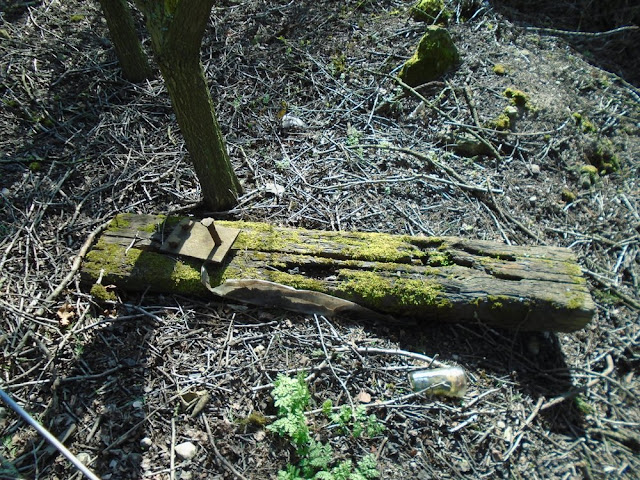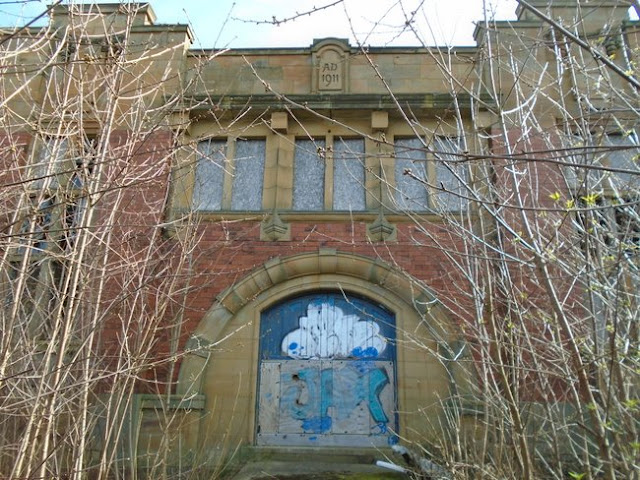Starting point - Micklefield station. 4.2 Miles round trip. Cafe facilities at Ledston Luck colliery site.
Map today 1953 Map
Not far from Micklefield Station between Leeds and York was once the site of Peckfield Colliery, the name Pit Lane a giveaway to the former use of the site. Sunk in 1872, the pit operated for over a century before closing in 1981 by which time there were 5 miles of roadway between the pit head and coal face making the pit quite uneconomical. This Yorkshire Evening Post article recalls the closure of the mine. Sadly like a number of coal mines the most notable event in its history was an accident, the Peckfield Pit disaster on 30th April 1896 in which 63 men and boys were killed. More information about the disaster can be read on Wikipedia.
Little can be seen of Peckfield colliery now, the site now being an industrial estate.
Below - Memorial to Peckfield Colliery and the Peckfield Pit Disaster.
Below - At this foot crossing on the railway the nearest set of tracks are a remnant of the railway connection to the mine.
From Peckfield Colliery a narrow gauge railway line connected a nearby pit that wasn't on the main line railway network, Ledston Luck Colliery. The 2ft 6in gauge line followed Ridge Road which itself followed the course of a Roman road (does that mean the Romans engineered the course of a railway?)
I took my bike for this visit as parts of Ridge Road lack pavements, though walking on the grass verge should be possible. Visiting in March 2021 the vegetation was still thin from winter so the course of the railway was visible in the bushes at the side of the road and in a couple of places where roads went off to the east old bridges were still in situ.
Below - Farm track crossing over a brick bridge that once took it over the railway to Ledston Luck.
Below - A small concrete tunnel where the road has been widened for a roundabout at the junction with Selby Road.
Below - Close to the site of Ledston Luck Colliery I found a sleeper from the old railway.
With several firms building locomotives in nearby Leeds the line was handy to test and demonstrate locomotives built to this gauge on a stretch of line that was above ground.
Below - Hudswell Clark loco D1044 with a party of officials from the makers and the Sierra Leone Railways pose for a photo at Ledston Luck in around 1954. (Photo - W.D.Ockenden Collection, leedsengine.info)
We now reach the site of Ledston Luck colliery itself. Many of the pit buildings survive, at the time of writing either in a derelict state or in new uses. The buildings date to 1911. The mine used electric power for winding and although the head gear has gone the winding houses are still in situ.
As we approach the colliery we move on to another old map sheet and a
1952 map
Below - Number 1 and Number 2 winding houses.
More detail of exploring the winding houses can be found on the
28 Days Later website, including a look inside the buildings. With the chipboard boarding over the windows and doors having rotten away some time ago I could have easily gone inside myself but I decided it was best to just poke my camera through the windows to take a peek inside.
Like many mines in the years following the 1947 nationalization it was extensively modernised to improve efficiency and working conditions. The pit gained a pit head bath complex at this point. These buildings have now found new uses, including a handy cafe for a snack and a drink before heading back to Micklefield, the Pit Stop Cafe.
With the closure of Peckfield Colliery, Ledston Luck gained its own washing plant in 1983, having sent its coal by the narrow gauge railway to Peckfield previously. This led to the closure of the narrow gauge railway.
Despite Ledston Luck having been kept up to date with the latest improvements in mining over the years it closed just three years later in 1986. Many of the closures of smaller pits in the area saw miners transferring to the modern superpit near Selby.
After closure the washing plant was demolished and the site is now a lorry park, apparantly some rails and a wagon turntable survive in the concrete of the lorry park, though that is a private site so I didn't get to see these.
Land around the colliery, including the former tips is now a nature reserve.
A picture of the colliery, probably shortly after closure can be found
here











No comments:
Post a Comment